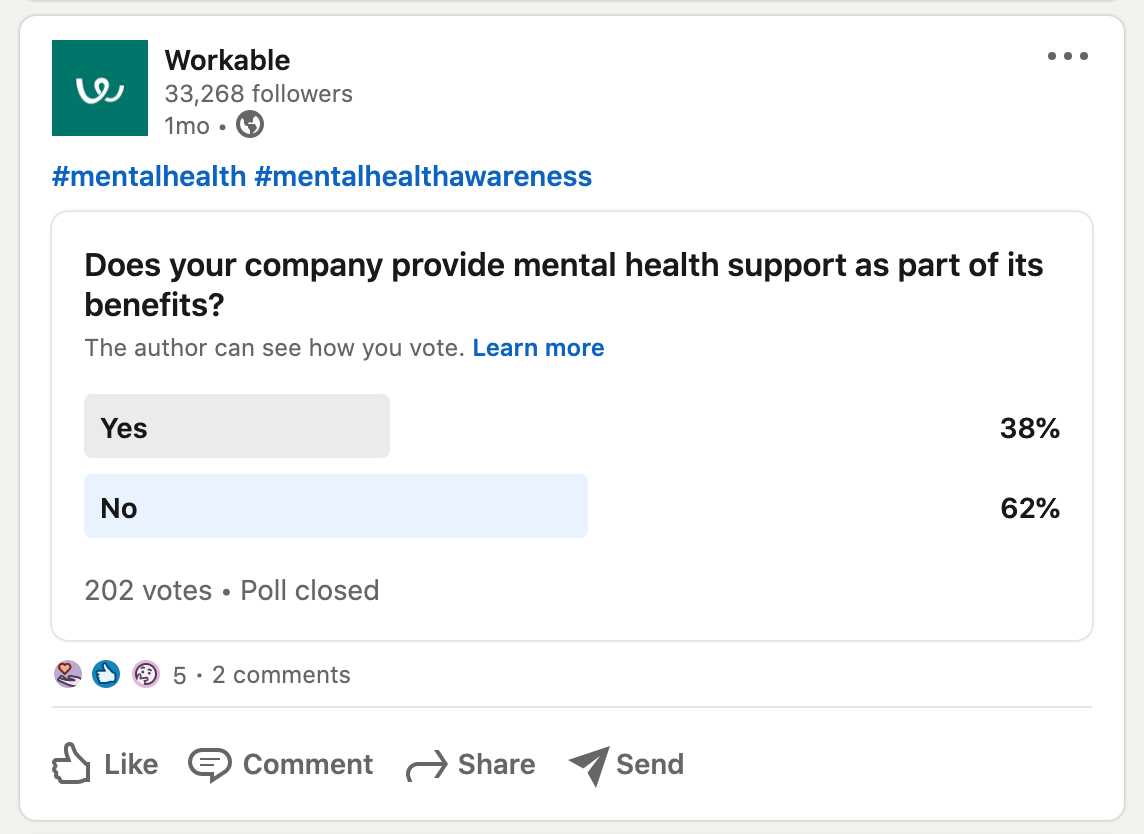Workplace mental health: Support your employees through the deep dark winter
Winter is coming. Yes, that quote is mostly accredited to the Stark folks in Game of Thrones, but it applies here and now in terms of workplace mental health as well. Cases and, sadly, deaths related to COVID-19 are increasing, with predictions of close to half a million US-based deaths by February according to the CDC.

And seasonal affective disorder – also known as the winter blues – coupled with flu season and reduced ability to visit with family during a normally festive season, will amount to a very difficult winter for employees, especially in the more northern climes.
These days, the line between work life and home life is increasingly blurred by the shift to remote work and an intense social and political environment worldwide (Black Lives Matter, Brexit, the pandemic itself) that ultimately spill over into the workplace, impacting engagement and productivity.
You, as an employer and HR practitioner, need to help your employees. Why? Well, for one, they expect this from you. 75% of Gen Z and half of Millennial employees have left work for mental health reasons according to one study – and turnover is expensive. Untreated mental health costs the US economy $200 billion, according to another study. And untreated depression costs employers an average of $9,450 per employee per year, says a third.
An informal Workable poll on LinkedIn in November 2020 found that 62% of employees say their company doesn’t offer mental health support as part of its benefits:
Finally – the 2021 Deloitte Global Human Capital Trends report highlights workplace wellbeing as a leading priority in workplace transformation according to employees. That stands in stark contrast to executives, who listed that as only the second-to-last priority in a list of outcomes. The report states: “executives who deprioritize wellbeing as a goal of work transformation are missing a huge opportunity.”
So, as a business, you’re not only morally obliged to support your employees through this deep dark winter – it also makes business sense to do so.
Seven tips for workplace mental health
So, we’re sharing seven insights from the SMB and HR communities to help you and your employees get through this long, difficult winter before the days become brighter and vaccinations start to roll out to more and more people going into 2021. Here they are, all with the end goal of maintaining and even boosting your workplace mental health:
1. Establish an open-door policy
Because mental health can be a sensitive topic – and stigmatized in many cases – many employees are afraid to approach their managers or even human resources to seek support. In fact, one study found that 50% of employees feel “very uncomfortable” discussing mental health with a current or prospective employer, compared with 10% who said the same about discussing it with a friend or family member.
This means you need to open the door for your employees and help them feel comfortable stepping forward with their problem, says Stephen Light, a certified stress management coach and co-owner of Colorado-based Nolah Mattress:
“Ideally, employees should have no apprehensions in sharing their problems with managers and supervisors, primarily if it affects their work performance.”
He found that not only did it help in terms of work performance – it also boosted company morale.
“We noticed that not only did the open-door policy improve the overall mental health of reorganization, but it also developed the relationships of managers and their subordinates. Through their one-on-one conversations, employees’ trust in their managers grew, which established a connection beyond the leader-follow set-up.”
Rick Hoskins, founder of air filter company Filter King in Alabama, also has an open-door strategy in his workplace mental health policy, and that applies to all leaders and managers in his organization as part of a formal setup.
“This means that employees are welcome to come to talk at any point, professionally or personally, without judgement or fear of losing their job,” says Rick.
Note: Download our workplace mental health policy template and customize to your specifications.
2. Train your managers and employees
To have a truly successful workplace mental health policy, you need to create a holistically supportive work environment in which employees can thrive. That means training and empowering your employees so they’re best set for success.
Matt Bertram, CEO of EWR Digital, makes sure this happens in his Houston-based SEO marketing agency.
“We started a wellness support strategy in September. The aim of our strategy is to empower our employees to take better care of themselves and become more resilient.”
He also took aims to ensure managers followed suit.
“Our managers have been directed to openly show empathy and vulnerability towards our employees. We regularly ask our employees how they are. We find out how they are taking care of their mental health and encourage everyone to share what’s working for them.”
3. Don’t just talk the talk – walk the walk
Making a statement for workplace mental health is noble, but in many cases, it’s not enough; that’s simply performative action as opposed to proactive action, according to Inclucive and Allyship founder and DEI consultant Chikere Igbokwe. You need to step up and implement procedures and activities that your employees can willingly participate in.
One way of doing so is establishing a physically healthy work environment as well as a mentally healthy one. Uphold the spirit of the Latin phrase: Mens sana in corpore sano, loosely translated to English as: “A healthy body means a healthy mind”. While physical health of course is not the sole means of maintaining mental health, it’s helpful and actionable, and creating a work environment that promotes this can be hugely beneficial.
Matt speaks to this as well: “Our employees are directed to prioritize their health and family. We allow for flexibility at work to allow employees to balance work activities with home and wellness responsibilities. Healthy habits like exercise, sleep, nutrition, meditation, and time with loved ones are encouraged.”
There’s more you can do in addition to promoting and enabling healthy habits. CEO Aylon Steinhart’s San Francisco-based vegan ice cream company Eclipse Foods introduced tech tools as part of its mental health policy:
“We have recently added wellness apps such as Headspace to our benefits package to give our employees more tools they may need to get through these tough times.”
Those still working in the office – and those about to return as we head out of the pandemic – can provide healthier, cheaper snacking options in the kitchen. Ethan Taub, CEO of an “online mall” for financial services, Goalry.com, did this in his office in Newport Beach, California:
“One simple practice which I think helps the mental and physical wellbeing is introducing free fruit stations within the office. It helps with snacking but the vitamins have a positive impact on the mind, therefore making your workers more productive whilst helping them with their health.”
When his company went virtual, he took it to another level:
“As things have been more difficult this year, our staff have actually been receiving free fruit hampers directly to their front door on a weekly basis. It helps us to stay in touch with one another but also look after our mental and physical well being through these little gift baskets.“
4. Encourage camaraderie and collaboration
When the days get shorter and shorter and the weather outside gets worse and worse – particularly in northern climes – people will spend more time indoors. Stay-at-home advisories and lockdowns associated with the COVID-19 pandemic, plus numerous days working out of the home with little to no socialization can take its toll on workplace mental health.
When there isn’t a space for organic interaction between colleagues, you’ll need to step up and establish that environment – even virtually – to keep that spirit alive.
Aylon has taken the steps to make sure that camaraderie and collaboration continue to thrive despite working entirely online:
“From daily team check-ins to weekly virtual happy hours, it’s important that our employees see one another not just as coworkers but as real people who are going through this pandemic with one another,” Aylon says. “We are each other’s support system in these unparalleled times.”
Matt at EWR Digital also points to the collective company goal – including its deeper meaning – as a key to keeping employees motivated.
“We strengthen our group connections by cultivating a shared sense of purpose. Employees are helped to find meaning in their work and understand the importance of their individual contributions. This can make them feel more valued as a part of our team and stave of feelings of isolation or loneliness.”
5. Encourage a positive-thinking environment
The benefits of positive thinking are well documented in science: it helps maintain a strong immune system, reduces anxiety levels, and encourages healthier lifestyles and relationships both at home and in the workplace.
Part of positive thinking comes from within, via new habits such as daily statements of gratification, turning an “impossible” situation into a new and welcome challenge, and even simply smiling more and thinking positively about oneself. But another part of it comes from external sources – people feel more positive if they are appreciated by others.
Ted Sun, the president and CIO of Transcontinental University in Ohio, launched a strategy on empowerment at his school in early November and helped other executives implement the same in their workplace mental health strategy throughout.
“The basis of the strategy is to ensure that people are seen, heard, and feel like they have control,” says Ted. “We’ve implemented this into various systems including performance management systems, motivation systems, and learning systems.”
“Especially as we approached the end of the year, performance management has to be empowering. Hope for a brighter future has to be part of the conversation in the annual reviews.”
Ted adds that this isn’t an individual job – it needs to be a collective effort throughout the company.
“This powerful emotion also has to be in the daily language of all managers within the motivation systems. To do this, managers are getting additional development to master this (part of emotional intelligence development). In the learning systems, employees are getting additional skills to get a sense of control for their future.”
6. Hire a Happiness Coach
When you’re handling a company-wide workplace mental health initiative, someone needs to own that process whether as the leader of a team or as a dedicated director. Brexit Project Managers are commonplace in the United Kingdom, whereas jobs focused on diversity and inclusion are surging, especially in 2020. So why not hire someone to be in charge of increasing workplace morale at your company?
That’s what Rick did in hiring a Happiness Coach when his team shifted to remote work.
“This is a company-wide dedicated employee happiness and wellness coach that was hired from within the current team. […] She is the most empathic of all the staff. Her role is to meet up with the different team members on a regular basis and be available for them to speak with her about their private issues. She conducts 360° surveys so applicable changes can be made in the day-to-day management.”
The benefits of having this in the company led to a much stronger understanding of employee needs and workplace mental health priorities, Rick found:
“Because of this, we were able to understand that people would prefer flexible working hours, and four-day working weeks. This was in the height of the pandemic and completely understandable.”
And of course, once you have that information on hand, you need to carry out on that promise of equipping your employees with what they need in order to do their job well.
7. Track the progress
As in any business, establishing a tracking mechanism is crucial to success when launching a new initiative – be it DEI, a new product release, or expansion into new markets. The executives in your business will of course be interested in the wellbeing of your staff, but if they can have documentation in their hands that point to the real value of what you’re doing, then that’s even better.
This means you need to track your progress in workplace mental health and report on it in a very tangible way.
Ted makes sure to have a tracking mechanism in place as part of the mental health initiative in his workplace.
“All people have emotional intelligence data as we’ve focused on developing the EQ of all staff,” he says. “We regularly track the EQ development with various development activities. Optimism is also another metric we use to ensure people are engaged in a positive way contributing to the ideal outcomes.”
Ted also uses metrics to ensure that people follow through on the promise:
“We have systems in place to hold people accountable to learning and growing their EQ in addition to other intelligences like analytical and systems thinking.”
Rick found that tracking and reporting can be as simple as having a regular cadence in the strategy:
“Having a fixed meeting every six weeks with the Happiness Coach obliges the quieter employees to speak, who often have the best ideas and most hidden emotions. There are others then who are more than happy to have a type of Agony Aunt to vent to.”
A mutually supportive work environment
There is no clear-cut prescription to maintaining workplace mental health throughout the wintertime, particularly during a devastating pandemic and social unrest. However, simply implementing a few of the tips listed above can have a positive impact on your business and on your employees and colleagues, as Matt at EWR Digital found:
“We have an uplift in employee engagement following the implementation of our [wellness support] strategy. This has translated to an increase in productivity across all our projects.”
Rick pointed to a mixture of tangible and intangible benefits to actively supporting employees during 2020:
“I can’t tell you for sure if productivity rose because people had flexible hours, because they were at home, because we have a Happiness Coach, or because of all of the above.
“What I can share with you is that deadlines are being met with ease and there is less of a sense of stress during meetings. We completed year-end goals in August and are able to project higher goals for 2021.”
At the core of it all is this: your employees and your colleagues are human beings, each of whom are experiencing 2020 in different and unique ways. What you can do for them is establish an environment where they can feel safe and supported in the workplace – you want them to want to come to work every day and be their best selves.
Headspace’s 2020 Mental Health Trends report finds that companies and their leaders need to develop a better understanding of their employees’ needs, one of which is more evidence-based mental health tools resources as part of overall support in the workplace. The above-listed tips will be a good first step in getting through the deep dark winter – and beyond.





